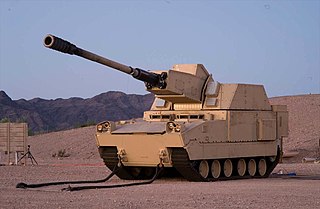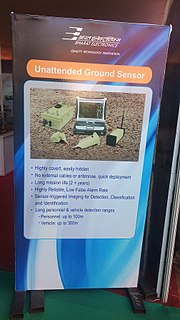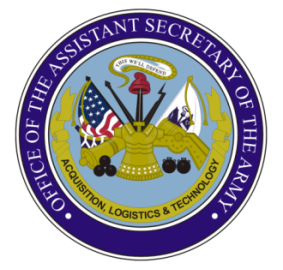
The United States Army (USA) is the land service branch of the United States Armed Forces. It is one of the eight U.S. uniformed services, and is designated as the Army of the United States in the U.S. Constitution. The oldest and most senior branch of the U.S. military in order of precedence, the modern U.S. Army has its roots in the Continental Army, which was formed 14 June 1775 to fight the American Revolutionary War (1775–1783)—before the United States was established as a country. After the Revolutionary War, the Congress of the Confederation created the United States Army on 3 June 1784 to replace the disbanded Continental Army. The United States Army considers itself to be a continuation of the Continental Army, and thus considers its institutional inception to be the origin of that armed force in 1775.
Network-centric warfare, also called network-centric operations or net-centric warfare, is a military doctrine or theory of war that seeks to translate an information advantage, enabled in part by information technology, into a competitive advantage through the robust computer networking of well informed geographically dispersed forces. It is based on ideas of marshal of USSR Nikolai Ogarkov, set out by him in early 1980s. It was pioneered by the United States Department of Defense in the 1990s.

Future Combat Systems (FCS) was the United States Army's principal modernization program from 2003 to early 2009. Formally launched in 2003, FCS was envisioned to create new brigades equipped with new manned and unmanned vehicles linked by an unprecedented fast and flexible battlefield network. The U.S. Army claimed it was their "most ambitious and far-reaching modernization" program since World War II. Between 1995 and 2009, $32 billion was expended on programs such as this, with little to show for it.

The Combat Capabilities Development Command (CCDC) C5ISR Center, formerly the Communications-Electronics RD&E Center (CERDEC), is the United States Army information technologies and integrated systems center. CCDC C5ISR Center is headquartered at Aberdeen Proving Ground in Maryland, with activities at Fort Belvoir in Virginia and Joint Base McGuire-Dix-Lakehurst in New Jersey.

The XM1203 Non-Line-of-Sight Cannon (NLOS-C) was a 155 mm self-propelled howitzer. It was the lead vehicle for the U.S. Army's Future Combat Systems Manned Ground Vehicles program.

The reorganization plan of the United States Army is a current modernization (2017–2028) and reorganization (2006–2016) plan of the United States Army that was implemented (2006–2016) under the direction of Brigade Modernization Command. This effort formally began in 2006 when General Peter Schoomaker, was given the support to move the Army from its Cold War divisional orientation to a full-spectrum capability with fully manned, equipped and trained brigades; this effort was completed by the end of 2016. It has been the most comprehensive reorganization since World War II and included modular combat brigades, support brigades, and command headquarters, as well as rebalancing the active and reserve components. The plan was first proposed by the Army's 34th Chief of Staff, Eric Shinseki, in 1999, but was bitterly opposed internally by the Army.

The Philippine Marine Corps (PMC) is the marine corps of the Philippines, a naval infantry force under the command of the Philippine Navy. The PMC conducts amphibious, expeditionary, and special operations missions.

Command and control is a "set of organizational and technical attributes and processes ... [that] employs human, physical, and information resources to solve problems and accomplish missions" to achieve the goals of an organization or enterprise, according to a 2015 definition by military scientists Marius Vassiliou, David S. Alberts, and Jonathan R. Agre. The term often refers to a military system.
A program executive officer, or PEO, is one of a few key individuals in the United States military acquisition process. As can be seen from the examples below, a program executive officer may be responsible for a specific program, or for an entire portfolio of similar programs.

The Operational Test and Evaluation Force (OPTEVFOR) serves as an independent and objective agency within the United States Navy for the operational testing and evaluation (OT&E) of naval aviation, surface warfare, submarine warfare, C4I, cryptologic, and space systems in support Navy and U.S. Department of Defense acquisition programs.

The unattended ground sensor (UGS) is under development as part of the United States Army's Future Combat Systems Program. For information on currently fielded UGS systems, refer to the Current Force UGS Program or CF UGS.

The Manned Ground Vehicles (MGV) was a family of lighter and more transportable ground vehicles developed by BAE Systems and General Dynamics as part of the U.S. Army's Future Combat Systems (FCS) program. The MGV program was intended as a successor to the Stryker of the Interim Armored Vehicle program.

The Office of the United States Assistant Secretary of the Army for Acquisition, Logistics, and Technology is known as OASA(ALT). OASA(ALT) serves, when delegated, as the Army Acquisition Executive, the Senior Procurement Executive, the Science Advisor to the Secretary of the Army, and as the senior research and development official for the Department of the Army. The OASA(ALT) also has the principal responsibility for all Department of the Army matters related to logistics.

The Ground Combat Vehicle (GCV) was the United States Army's replacement program for armored fighting vehicles in Armored and Stryker brigade combat teams. The GCV was organized under the Follow On Incremental Capabilities Package of the BCT Modernization program. The first variant of the vehicle was to be prototyped in 2015 and fielded by 2017. It replaced the canceled Future Combat Systems, manned ground vehicles program. The GCV program was cancelled in February 2014. Its replacement was the Optionally Manned Fighting Vehicle.
FCS/BCT unmanned aerial vehicles was a collection of unmanned aerial vehicles developed under the jurisdiction of the Future Combat Systems (FCS) program until it was dissolved and succeeded by the BCT Modernization program.

The Ground Combat Infantry Fighting Vehicle was an infantry fighting vehicle being developed for the U.S. Army. The program originated as the lead vehicle of the U.S. Army's Ground Combat Vehicle program coordinated by TACOM and spawned a parallel program coordinated by DARPA. The purpose of the program was to replace existing armored personnel carriers and infantry fighting vehicles in U.S. Army service. The DARPA project aimed to have the vehicle designed by 2015. Derivatives of the vehicle based on a common chassis—such as tanks and ambulances—were expected to be manufactured. It replaced the previous attempt at a next-generation infantry transport, the XM1206 Infantry Carrier Vehicle. The Ground Combat Vehicle program was cancelled in February 2014.

The United States Army Futures Command (AFC) is a United States Army command, designed as a public-private initiative, that runs modernization projects for the Army. It is headquartered in Austin, Texas, and was first commanded by General John Murray.
The Internet of Military Things (IoMT) is a class of Internet of things for combat operations and warfare. It is a complex network of interconnected entities, or "things", in the military domain that continually communicate with each other to coordinate, learn, and interact with the physical environment to accomplish a broad range of activities in a more efficient and informed manner. The concept of IoMT is largely driven by the idea that future military battles will be dominated by machine intelligence and cyber warfare and will likely take place in urban environments. By creating a miniature ecosystem of smart technology capable of distilling sensory information and autonomously governing multiple tasks at once, the IoMT is conceptually designed to offload much of the physical and mental burden that warfighters encounter in a combat setting.
The XM1100 Scorpion, formerly known as the Intelligent Munitions System, was an anti-vehicle, smart ground munition developed by Textron Defense Systems as a safer alternative to traditional landmines. The Scorpion was originally a component of the Future Combat Systems program. It was a remotely controlled, integrated system of lethal and non-lethal munitions, ground sensors, and communication technology that could autonomously detect, track, and destroy light-wheeled to heavy-tracked vehicles.











